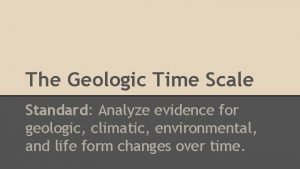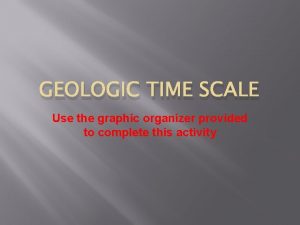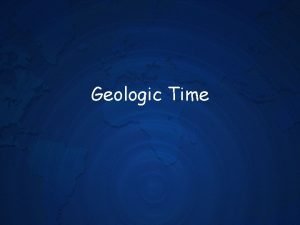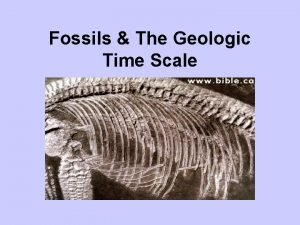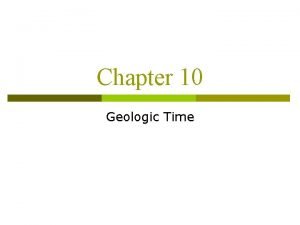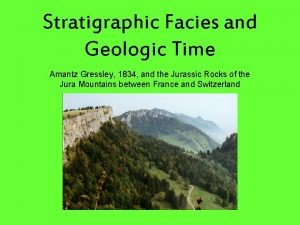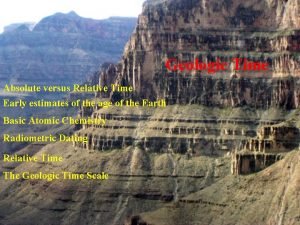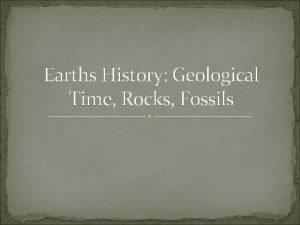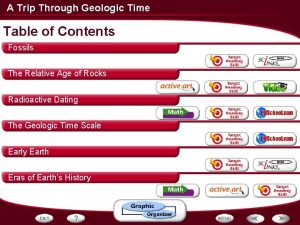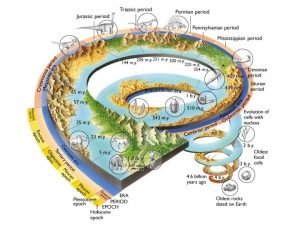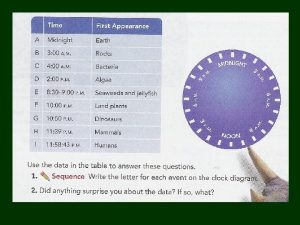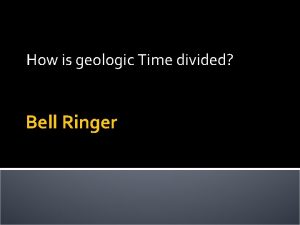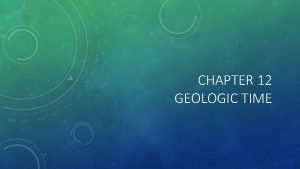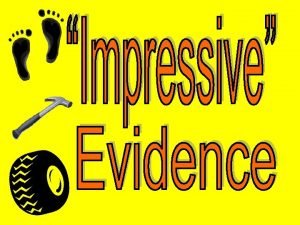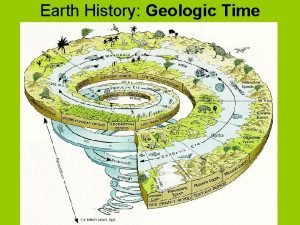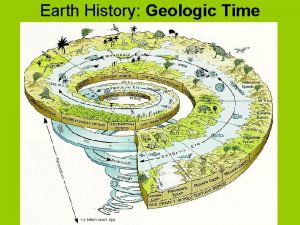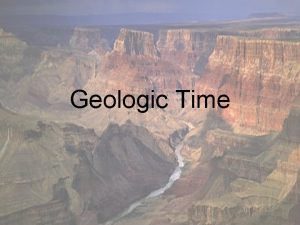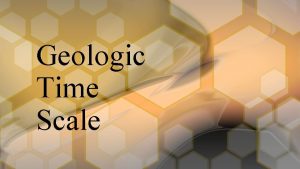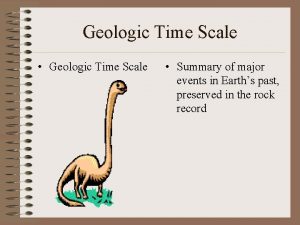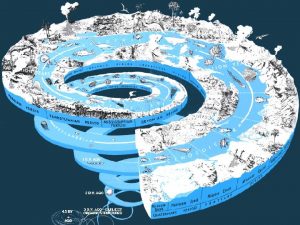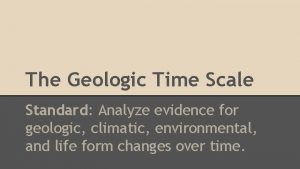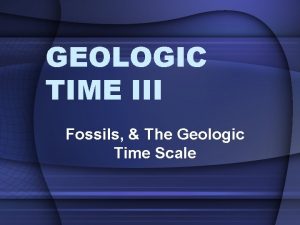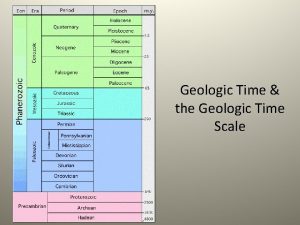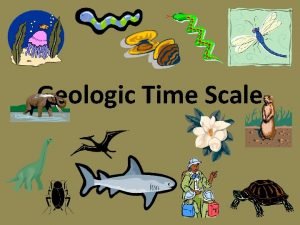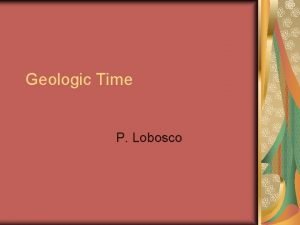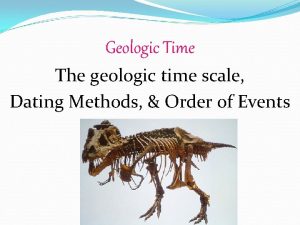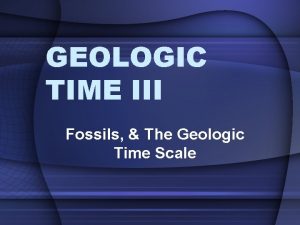The Geologic Time Scale Standard Analyze evidence for


















- Slides: 18

The Geologic Time Scale Standard: Analyze evidence for geologic, climatic, environmental, and life form changes over time.

K. I. M. Sheets Fill out the Vocab Terms on your K. I. M Sheet Geology Catastrophism Absolute Dating Geologic Time Scale Uniformitarianism Relative Dating

Studying Rock “How old is Earth? ”, “How does new rock form? ”- Questions asked by scientists studying geology. Geology is the scientific study of the origin, history, structure and processes of Earth.

Changes Occur Suddenly: Early scientists (100 s to 1000 s of years ago) used catastrophism to explain geologic change. Did not understand the slower, gradual changes that were more difficult to see!

Catastrophism In 2010, Merapi volcano in Indonesia erupted, releasing millions of cubic meters of ash, dust and gases, that fell 100 s of miles away. Catastrophism is the principle that states all geologic change occurs suddenly.

Changes Occur Gradually 250 yrs ago, Scottish farmer/scientist studied rock formations. Years of observation challenged catastrophism. (James Hutton) Led to foundation of modern geology.

Uniformitarianism Processes like erosion and deposition take long periods of time to observe change. Uniformitarianism is the idea that the same geologic processes that shape Earth today have been at work throughout Earth’s history.

Modern Geology Today Geologists now realize that changes occur both Catastrophically and Gradually. While most geologic change is gradual, forces like earthquakes, floods, volcanic eruptions and asteroid impacts continue to cause sudden changes to the face of Earth.

Relative Dating is determining how old an object or event is by comparing the rock layer in which it was found.

Absolute Dating Determining the actual age of an event or object in years is called absolute dating. ❏Radioactive Decay ❏ Radiocarbon Dating (only organic/45, 000 yrs) ❏ Potassium-Argon Dating (volcanic rock) ❏ Uranium-Lead Dating (rocks-100 to billion yrs) ❏Half-life

Geologic Time Scale Earth is OLD, 4. 6 Billion years old! How do we make sense of this vast time frame? Geologists use the geologic time scale to organize Earth’s history. The geologic time scale divides Earth’s history into intervals of time defined by major events or changes on Earth.

Divisions of Time Largest unit of geologic time is an Eon. ❏ Precambrian Time = 90% of Earth History Eons divided into smaller groups called Era’s. ❏ Paleozoic ❏ Mesozoic ❏ Cenozoic Each Era is subdivided into Periods and divided into Epochs.

Divisions of Time (cont. ) Unlike divisions of time such as days or minutes, the geologic time scale has NO fixed lengths. Many Divisions are based entirely on the fossil record.

Divisions of Time (cont. ) There are 5 divisions of geologic time that have ended in large mass extinction events. Organisms disappear from the fossil record.

Events of Precambrian Time Began with formation of Earth 4. 6 billion years ago. ❏ Continents began to form. ❏ Atmosphere made mainly of gases released from volcanoes. ❏ Water vapor fell and pooled to form first Oceans ❏ Cyanobacteria, living in oceans, began releasing oxygen during photosynthesis.

Events of the Paleozoic Era Began 540 million years ago. ❏ Formation of Pangaea begins ❏ Life quickly began to colonize land ❏ Cambrian “Explosion” leads to most major groups of organisms ❏ Permian Extinction at end of Era wiped out 90 -95% of marine life and 70% of land species

Events of the Mesozoic Era Began about 250 millions years ago. ❏ Pangaea breaks apart ❏ Atlantic Ocean opens up between America and Africa ❏ Sea levels rise ❏ Carbon Dioxide builds up in atmosphere from volcanic eruptions to warm planet ❏ Warm climate dominated by Dinosaurs ❏ Asteroid impact 65 million years ago wiped out Dinosaurs while smaller mammals survive.

Events of the Cenozoic Era Began 65 Million years ago ❏ Continents assumed their current position ❏ Himalayas form when India collides with Eurasia ❏ Climate cooled, forming polar ice caps ❏ Divided into Tertiary and Quaternary ❏ Quaternary characterized by an ice age ❏ Modern humans evolved during late Quaternary
 Compare geologic time with the geologic column.
Compare geologic time with the geologic column. How is the geologic time scale organized
How is the geologic time scale organized Graphic organizer of geologic time scale
Graphic organizer of geologic time scale How is the geologic time scale organized
How is the geologic time scale organized Geologic time scale animals
Geologic time scale animals Geologic time scale drawing
Geologic time scale drawing Geologic time scale drawing
Geologic time scale drawing Geologic time scale
Geologic time scale Geologic time scale
Geologic time scale Geologic time scale poem
Geologic time scale poem Geologic
Geologic Geologic time scale drawing
Geologic time scale drawing Fossils
Fossils Geologic time
Geologic time Largest division of geologic time
Largest division of geologic time Time scale
Time scale What is the longest subdivision in geologic time
What is the longest subdivision in geologic time Chapter 12 geologic time
Chapter 12 geologic time Example of impression evidence
Example of impression evidence

